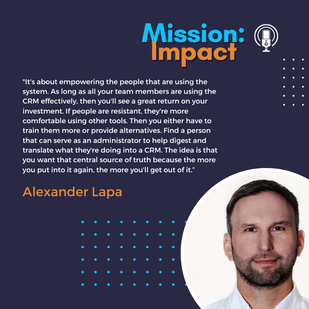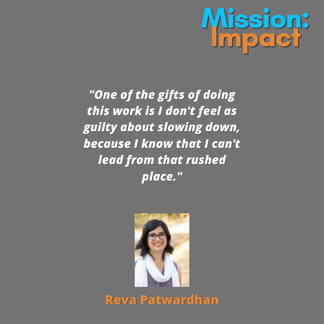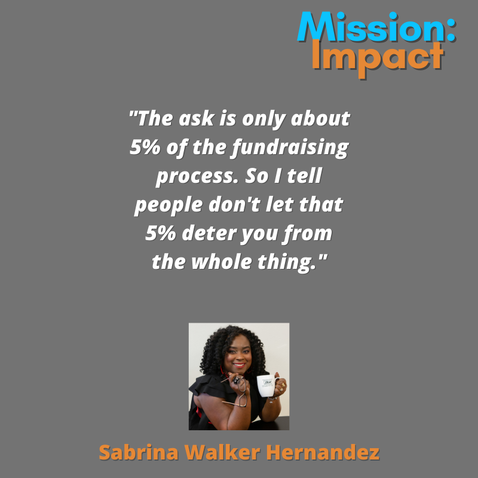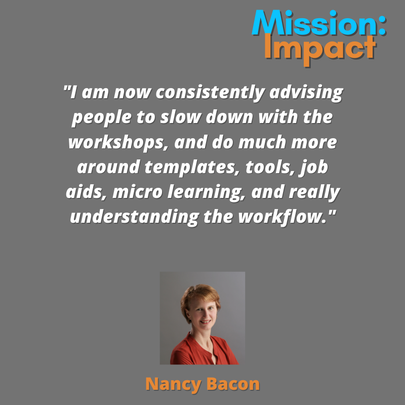Mission: Impact podcast & blog
Build a better world without becoming a martyr to your nonprofit cause
Listen on:
 In episode 83 of Mission: Impact, Carol Hamilton and Alexander Lapa delve into the benefits of using a Customer Relationship Management (CRM) system like Salesforce for nonprofits. These include improved data management and streamlined processes. Alexander shares his expertise in setting up and optimizing CRM tools for nonprofits. He explains why having a consultant to guide organizations through the complexities of finding the right tool to meet where they are in their stage of development is helpful. The conversation also explores challenges in fully utilizing a CRM system and the need for training and support to empower users as well executive sponsorship. Integration, AI, and organizational culture in nonprofit CRMs are also discussed. Episode Outline:
(00:08:30) Benefits and Challenges of Using a CRM (00:13:36) Leveraging CRM for Effective Communication (00:18:28) Integration and AI in Nonprofit CRMs (00:23:40) Challenges with CRM Adoption Guest Bio: Alex is a Salesforce Architect & Advisor who helps nonprofits improve their social impact. He has 10 years of Salesforce and nonprofit experience and 20 years of CRM experience. Aside from working on CRM projects, Alex is host of "Agents of Nonprofit". It's a weekly podcast that interviews guests about products and services which help nonprofits. It's often discusses the benefits of technology, and currently has nearly 70 published episodes. Alex also shares his experience in a short daily email, helping junior Salesforce consultants level-up their knowledge, deal with challenging clients, and advocate for a digital nomadic lifestyle. Episode Links: https://dryadconsulting.com/welcome https://www.linkedin.com/in/alexanderlapa https://podcast.agentsofnonprofit.com/ Click "Read More" for Transcript  I love to read. One of my favorite parts of any book is the Acknowledgments section. I haven’t written a book yet - and I may never do that - but I would like to acknowledge all the people this year who were generous enough to have me on their podcast to talk about my favorite subject - nonprofit strategic planning. Every time I get to talk to someone about strategic planning, why I do it and why it is important for nonpropfit organizations, I learn something new about the practice and process. I am not necessarily a “think out loud” external processor and yet through these conversations I deepened my understanding by having to explain things to others that sometimes seem obvious to me. One thing that I certainly have learned over the course of my career is that what is obvious to me - or anyone - is NOT necessarily obvious to others or even how they think about a thing. And that in itself is one of the reasons I love facilitating strategic planning processes. Folks have to talk through with each other what might be obvious to them and implicit in how they work – but needs to get explicit if the whole group is going to get behind the idea and move a strategic initiative forward. Because of that learning and deepening I am so grateful for each opportunity I had to explore the topic this year. Connecting to my valuesDuring my Own Your Expertise interview with Emily Crookston, PhD., I realized that my faith tradition’s 1st and 7th principles - the inherent worth and dignity of every human being and the interconnectedness of all things really undergird my work with nonprofit organizations. I don’t think I had made that connection before we talked. Reevaluating your strategic planIn my conversation with Carolyn Mozell, the host of Use Your Powers for Good podcast, we talk about how to stay accountable to the strategic plan and why it is so important for your nonprofit organization to agree on a process for reevaluating and reviewing your plan on a regular basis - whether that is quarterly, every six months - or at minimum every year. Making the nonprofit strategic planning process worth your timeTalking with Stu Swineford, host of the Relish this podcast, we explored what goes into making a nonprofit strategic planning process worth it. As Stu put it, it’s a valuable exercise that aligns your team, creates thrust for your nonprofit organization, and builds an actionable plan to keep you on track for the short- and longer-term. I really appreciate the idea of a plan helping generate momentum that propels the organization forward. Moving beyond the fears of strategic planningWith Julia Campbell, the host of the Nonprofit Nation podcast, we talked about what people fear about strategic planning and how that gets in the way of making it effective. Letting go of past bad experiences with nonprofit strategic planningBetina Pflug, the host of the Wisdom for Nonprofits podcast, and I talked about the frequent bad past experiences people have had with nonprofit strategic planning and how to make the process fun and useful. And why I do NOT have group’s start with a review of their mission and vision. VUCA doesn't mean planning is uselessDavid Pisarek, host of Nonprofit Digital Success, and I explored why you don’t need to throw out the idea of nonprofit strategic planning even though we do live in a VUCA (Volatile, Uncertain, Chaotic and Ambiguous) world. Nonprofits are essentially a network of people working together towards a common goal. The conversations the group has over the course of a strategic planning process helps everyone get clear about what is really important to focus on in the next 3-5 years and some first steps on how to move towards those goals. Without having those conversations periodically, a lot of “static” builds up in the system and folks may actually be working at cross-purposes instead of in a more powerful, aligned way. It's your nonprofit organization's plan, not mineHugh Ballou, host of the Nonprofit Exchange, and I talked about the myths about nonprofit strategic planning. One we honed in on was why it is important for the group, not the consultant, to write their own plan. Thanks! So thanks again to Emily, Carolyn, Stu, Julia, Betina, David, Hugh. And thanks for the service each of them provide the sector by creating their shows and helping those in the sector learn and deepen their practice.  In episode 53 of Mission: Impact, Carol and her guest, Reva Patwardhan discuss:
Guest Bio: Reva Patwardhan is the founder of Greater Good Coaching. She works with nonprofit leaders who’ve followed their hearts into careers of service and advocacy. She helps them discover their innate strength, resilience and confidence, so they can use their careers to make the impact they want in their lifetimes. She has 20 years of experience in the nonprofit sector as a fundraiser, communications director, lobbyist, board member, facilitator, coach and diversity trainer. Reva co-facilitates small experiential learning groups with the Stanford Graduate School of Business. She chairs the Board of Directors at Rethink Media. She is a certified Integral Coach, and a member of the International Coaching Federation. Important Links and Resources:
Click "Read More" for Transcript:  In episode 26 of Mission: Impact, some of the topics that Carol and her guest, Sabrina Walker Hernandez discussed include:
Sabrina Walker Hernandez is the President & CEO of Supporting World Hope. She has over 25 years of experience in nonprofit management, fundraising, and leadership. One of Sabrina’s greatest successes is that she increased operation revenue from $750,000 to $2.5 million over an 8-year period as well as being responsible for the planning and operations of a $12 million comprehensive capital campaign in the 3rd poorest county in the United States. She has also facilitated numerous workshops with hundreds of nonprofit professionals and is a master trainer for the Boys & Girls Clubs of America. Sabrina is certified in Nonprofit Management by Harvard Business School. She is an active community leader and volunteer in Edinburg, Texas where she is based. Important Guest Links:
Click "Read More" for Transcript:  In episode 19 of Mission: Impact, some of the topics that Carol and her guest, Nancy Bacon discussed include:
Guest Information: Nancy Bacon is a teacher, instructional designer, and learning strategist who has worked for over 25 years in the nonprofit sector. She works with nonprofits, associations, and networks to strengthen how nonprofits are able to serve their communities. She has trained thousands of people in-person and online, speaks on learning and leadership, and writes books and blogs on topics at the intersection of learning and nonprofits. Nancy also co-hosts the Nonprofit Radio Show. Important Links:
|
Archives
April 2024

Grace Social Sector Consulting, LLC, owns the copyright in and to all content in and transcripts of the Mission: Impact podcast, as well as the Mission: Impact blog with all rights reserved, including right of publicity.
|
Telephone301-857-9335
|
info[at]gracesocialsector.com
|
Grace Social Sector Consulting, LLC, owns the copyright in and to all content in, including transcripts and audio of the Mission: Impact podcast and all content on this website, with all rights reserved, including right of publicity.
|